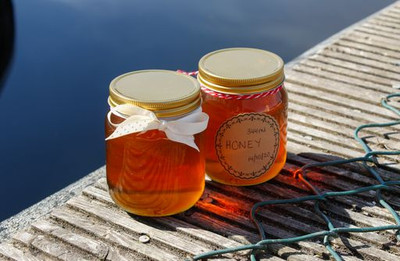How is honey made?
Posted by The Wares Team on 13th May 2021
We know that many of our customers are huge fans of honey. In fact, we sell a wide range of glass honey jars to store and display this beautiful golden amber nectar to its best effect, whether you're making your breakfast table look pretty with designer honey jars, or buying bulk glass honey jars to make and sell your own honey!
But how exactly does honey get made, and what's so special about this magical sweetener which, in its raw state, is also believed to have impressive health and beauty benefits?
The Queen hatches
Every honey process is begun with a queen and there's a queen bee reigning in every hive. Her job is to keep the hive working effectively, and when it gets too large, she starts to lay queen cells, which are nurtured by nurse bees. The queen is helped by being fed royal jelly, and when the queen cells are ready to hatch, the original queen usually leaves with her own small entourage, to make way for the new and strong virgin queen.
The mating flight takes place
Next, the mating flight occurs. The new virgin queen will mate on one occasion for her entire life, and the male drones are all waiting for this genuine once-in-a-lifetime opportunity. The queen takes flight high in the sky and the drones flock - and the strongest, fastest drone will be the lucky one (well, lucky in some ways as the mating process ultimately kills him, but we'll gloss over that bit...)
The male drone has accomplished his mission by carrying on his DNA, and the queen will lay fertile eggs.
Eggs are laid
The queen lays eggs, selecting which kind of bee will appear according to the need of the hive. Again, nurses feed the bees, selecting royal jelly for queens, until the eggs hatch and rapidly grow.
The new bees are ready to work
The male bees, or drones, simply wait for a virgin queen and the chance to mate with her. Worker bees are female and immediately begin to receive pollen, preparing to make honey. Some worker bees graduate to becoming nurse bees, or attendants to the queen. Most bees live for up to two months, and as they grow become adept at finding their own food. Meanwhile, the queen keeps busy laying around 1,500 eggs every day!
The worker bees collect pollen
Worker bees fly up to five miles away from their hive to collect pollen. They take some for energy, and then send the excess to their second stomach or storage pouch. They then return to the hive and return the extra nectar and pollen to worker bees in the hive. This is spread over prepared empty combs that other worker bees have made.
The honey is prepared
The honey is dehydrated once the comb is full, to remove water and to prevent spoilage. To do this, the bees flap their wings until they instinctively know that the honey is perfectly dehydrated. From this point, the honey is capped using wax that the bees themselves produce in their abdomen. They use this to cap the new comb, protecting it for storage. They can then eat the honey over winter.
The honey is harvested
Beekeepers come to harvest honey once the combs have been capped, checking the frames to see how far the process has gone. The beekeeper will cut the cap off each comb, usually by using a sharp knife. Then the frame is placed into a honey extractor, and the honey can be transferred into glass honey bottles and labelled for sale.
Beekeepers always make sure that they don't harvest too much honey, and leave plenty for their bees. The entire process is a fascinating mix of art and science, and the resurgence of local beekeepers is helping to keep Britain's essential bee populations strong.
Facts to know about honey
We can't get enough of this delicious sweet and natural product! Did you know..
- Honey never spoils? In fact, honey has been found in ancient Egyptian burial sites and it was still perfectly fit for consumption!
- A single beehive can produce up to 100 pounds of honey in a year
- The medieval feudal system relied on honey - thanks to its ability to sweeten beer - and local lords in parts of Europe required their peasants to make regular honey payments
- Honey has medicinal properties and is used in various ways, such as for antiseptic purposes directly onto cuts, taken internally to help with allergies and hayfever and in beauty products to prevent dandruff and dry skin conditions
- Only a few of the 20,000 species of bee make honey and they have been doing so for millions of years
- But there is also a species that isn't a bee which makes honey too.... the Mexican Honey Wasp!
Feeling ready to cook or even make your own honey? Check out our fantastic range of ceramic honey jars and glass honey jars today for inspiration.

